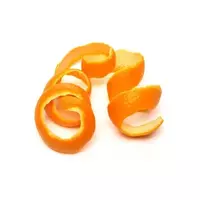Mandarin zest

Juicy, brightly coloured tangerines are not just a delicious refreshing flesh to feast on fresh or use as an ingredient when making many meals. These citrus fruits give people another important component - mandarin zest.
In general, by zest it is customary to mean the peel of various citrus fruits: orange, pomeranian (bitter orange), mandarin, grapefruit, lemon and lime. As a spice in cooking, an exceptionally bright top layer of skin is used, while it is removed without a subcortical layer of white color (it is too mustard).
Tangerine zest is characterized by orange color and sour-sweet rich taste with a light pleasant hill. In culinary affairs, it is customary to use mandarin zest not only in fresh form - quite often it is dried, after which it can be ground into powder. The calorie content of mandarin rind in fresh form is about 97 kcal, which are in one hundred grams of this aromatic spice.
Mandarin zest is widely used as a natural flavor, which sometimes easily replaces salt, ketchup or mayonnaise, which significantly reduces the calorie content of the dishes consumed. The aromatic and healing properties of mandarin zest can be used not only in salads and pastries to give them a characteristic subtle smell, but also in the preparation of various drinks and lemonades. In addition, delicious candied fruits can also be made from tangerine zest.
It should be noted that due to the unique composition, citrus peel acts as an excellent basis for the production of essential oils. These substances, in turn, are quite often the ingredients of many drugs.
Despite the fact that this spice cannot "boast" a large amount of fat and sodium in its composition, but the benefits of tangerine peel manifest themselves differently: in just 6 grams of dried peel, it contains about 14% of the daily norm of ascorbic acid. In addition, potassium, in sufficient quantities contained in this product, when ingested in humans, converts sugars into a useful glycogen that contributes to the regulation of blood pressure.
The Benefits of Mandarin Zest
The benefits of mandarin zest as a natural medicine have been scientifically proven in the treatment of edema due to the ability to bring the water-salt balance in the body to normal. Don't throw away the tangerine peel by eating juicy flesh - this fragrant zest helps combat dangerous cholesterol, largely reducing its levels.
Mandarin zest harms
Regarding the harm of mandarin zest to human health, it can be argued with full responsibility that it is almost unknown. But there are cases that excessive use of it provokes the development of local allergic reactions (in particular, in the presence of individual intolerance to the components of this fruit).
mandarin zest 97 kKal
Energy value of tangerine zest (Ratio of proteins, fats, carbohydrates - ju):
Proteins: 1.5 g (~ 6 kCal)
Fats: 0.2 g (~ 2 kCal)
Carbohydrates: 14.4 g (~ 58 kCal)
Energy ratio (bj | y): 6% | 2% | 59%
 Español
Español Français
Français Português
Português Русский
Русский 简体中文
简体中文 繁體中文
繁體中文 日本語
日本語 한국어
한국어 العربية
العربية Türkçe
Türkçe Қазақ
Қазақ Deutsch
Deutsch Italiano
Italiano Українська
Українська
